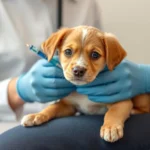
Introduction
Dog health care is a critical aspect of pet ownership, with weight management being one of the most important factors affecting a dog’s overall well-being. Obesity is a growing concern among dogs, particularly in breeds like pugs, who are prone to weight gain due to their unique body structure and lifestyle. According to the Association for Pet Obesity Prevention, approximately 56% of dogs in the United States are considered overweight or obese. This alarming statistic highlights the need for pet owners to take active steps toward maintaining their dog’s health, especially when it comes to managing weight.
This article focuses specifically on how to help a pug lose weight. Pugs, with their charming personalities and adorable wrinkled faces, can easily become overweight if not carefully monitored. Here, we will delve into practical strategies and insights to ensure your pug maintains a healthy weight and enjoys a happy, active life.
Understanding Pug Obesity
What is Canine Obesity?
Canine obesity is defined as an excess accumulation of body fat that can negatively affect a dog’s health. To determine if a dog is obese, veterinarians often use a body condition scoring system, which assesses a dog’s weight in relation to its ideal weight. This system usually employs a scale of 1 to 9, with scores of 5 indicating an ideal body condition. Dogs scoring 6 or above are classified as overweight or obese.
Causes of Obesity in Pugs
Several factors contribute to obesity in pugs, including:
- Genetic Factors: Some dogs are genetically predisposed to gain weight more easily than others. Pugs have a tendency to store fat due to their breeding history.
- Diet and Nutrition: Poor dietary choices, including high-calorie treats and low-quality dog food, can lead to weight gain.
- Lack of Exercise: Pugs are often less active than other breeds, leading to fewer calories being burned.
- Behavioral Factors: Overfeeding, begging for food, and using food as a reward can contribute to excessive caloric intake.
Health Risks Associated with Obesity
Obesity in pugs can lead to serious health complications, including:
- Joint Issues: Excess weight puts additional strain on joints, leading to arthritis and mobility problems.
- Heart Disease: Obesity increases the risk of heart disease, which can significantly shorten a pug’s lifespan.
- Diabetes: Overweight dogs are at a higher risk of developing insulin resistance and diabetes.
- Reduced Lifespan and Quality of Life: Overall, obesity can lead to a decreased quality of life and a shortened lifespan.
Assessing Your Pug’s Weight
Determining Ideal Weight for Pugs
Understanding your pug’s ideal weight is crucial for effective weight management. The standard weight range for pugs typically falls between 14 to 18 pounds. Indicators of a healthy weight include:
- Visual Assessment: A healthy pug should have a visible waist when viewed from above and a tuck when viewed from the side.
- Physical Assessment: You should be able to feel your pug’s ribs without excessive pressure, and there should be minimal fat covering.
Consulting with a Veterinarian
Before embarking on a weight loss journey for your pug, it’s important to consult with a veterinarian. A professional evaluation will help determine your pug’s ideal weight, assess any underlying health issues, and recommend appropriate health checks and screenings.
Creating a Weight Loss Plan
Developing a Balanced Diet
A well-balanced diet is essential for helping a pug lose weight. Here are some key points to consider:
- Understanding Dog Food Labels: Choose high-quality dog food with clear labeling on ingredients and nutritional content. Look for food with real meat as the first ingredient.
- Recommended Calorie Intake: The average pug requires about 400-600 calories per day, depending on their activity level. Adjust these numbers based on your dog’s individual needs.
- Types of Food to Include: Focus on high-protein, low-carb diets that promote weight loss and muscle retention.
- Portion Control Strategies: Measure food portions to avoid overfeeding. Using a standard measuring cup can help maintain consistent serving sizes.
Healthy Treats and Alternatives
Treats can significantly contribute to a pug’s caloric intake. Here’s how to make healthier choices:
- Treats to Avoid: Steer clear of high-calorie snacks like commercial dog treats, which often contain fillers and preservatives.
- Healthy Snack Options: Fruits and vegetables like carrots, green beans, and apple slices (without seeds) make excellent low-calorie snacks.
- The Importance of Moderation: Even healthy treats should be given in moderation to avoid excess calorie intake.
Incorporating Regular Exercise
Exercise is a vital component of any weight loss plan. Here are some suggestions for keeping your pug active:
- Recommended Types of Exercise: Pugs enjoy walking, playing fetch, and swimming. Each provides excellent cardiovascular benefits.
- Creating an Exercise Schedule: Aim for at least 30 minutes of moderate exercise daily, divided into short sessions to accommodate your pug’s stamina.
- Tips for Keeping Exercise Fun: Rotate activities to keep your pug engaged. Incorporate interactive toys and games to make exercise enjoyable.
Monitoring Progress
Keeping a Weight Loss Journal
Tracking your pug’s progress is essential for success. A weight loss journal can help you monitor:
- Food Intake: Document everything your pug eats, including treats and snacks.
- Exercise: Record daily exercise routines and durations to ensure consistency.
Regular Check-Ins with the Veterinarian
Schedule regular follow-up appointments with your veterinarian to:
- Evaluate Progress: Assess weight loss and overall health.
- Adjust the Weight Loss Plan: Make necessary changes based on your pug’s progress and any health concerns.
Celebrating Milestones
Positive reinforcement is crucial during your pug’s weight loss journey. Celebrate milestones by:
- Rewarding Progress: Use praise and affection rather than food to reward achievements.
- Creating Non-Food Rewards: Consider new toys or extra playtime as rewards for reaching weight loss goals.
Dealing with Challenges
Overcoming Plateaus in Weight Loss
It’s common for dogs to hit a plateau during their weight loss journey. Here’s how to overcome it:
- Common Reasons for Stalled Progress: This can happen due to a decrease in activity levels or unintentional overfeeding.
- Strategies to Overcome Plateaus: Reassess your pug’s diet and exercise routine. Consider incorporating more vigorous activities or adjusting portion sizes.
Managing Begging and Food Cravings
Pugs are known for their adorable begging behavior. To manage this:
- Tips for Reducing Begging Behavior: Ignore begging and avoid giving in to those puppy-dog eyes. Instead, reinforce good behavior with praise.
- Training Techniques: Use commands like “leave it” or “no” to discourage begging and establish boundaries around mealtime.
Addressing Underlying Health Issues
Sometimes, weight loss resistance can stem from health issues. Be vigilant for signs of problems, such as:
- Recognizing Signs of Health Problems: Increased thirst, lethargy, or changes in appetite can indicate health concerns.
- Importance of Veterinary Intervention: Regular check-ups can help catch any underlying issues that need addressing.
Long-Term Weight Management
Maintaining a Healthy Lifestyle Post-Weight Loss
Once your pug reaches a healthy weight, it’s important to maintain that status:
- Transitioning to a Maintenance Diet: Gradually adjust food portions and caloric intake to ensure your pug maintains their ideal weight.
- Importance of Continued Exercise: Keep up the regular exercise routine to prevent weight regain.
Educating Family Members
Ensure everyone in the household understands the importance of weight management:
- Strategies for Involving the Whole Family: Encourage family members to participate in exercise routines and share the responsibility of feeding healthy portions.
Staying Informed on Dog Health Care
Continuous education on dog health care is vital:
- Resources for Ongoing Education: Stay updated on canine health trends through reputable sources, including veterinarians and dog health websites.
- Importance of Staying Updated: Regularly inform yourself about the latest in dog nutrition and health care.
Conclusion
Maintaining a healthy weight for your pug is crucial for their overall health and happiness. By understanding the causes of obesity, assessing your pug’s weight, and creating a structured weight loss plan, you can help your pug achieve and maintain an ideal weight. Regular monitoring, overcoming challenges, and long-term lifestyle changes will ensure your pug enjoys a healthy, active life.
Taking action today can lead to a happier, healthier future for your beloved pug. Remember, the benefits of maintaining your pug’s ideal weight extend beyond physical health; they also contribute to a better quality of life and longevity.









